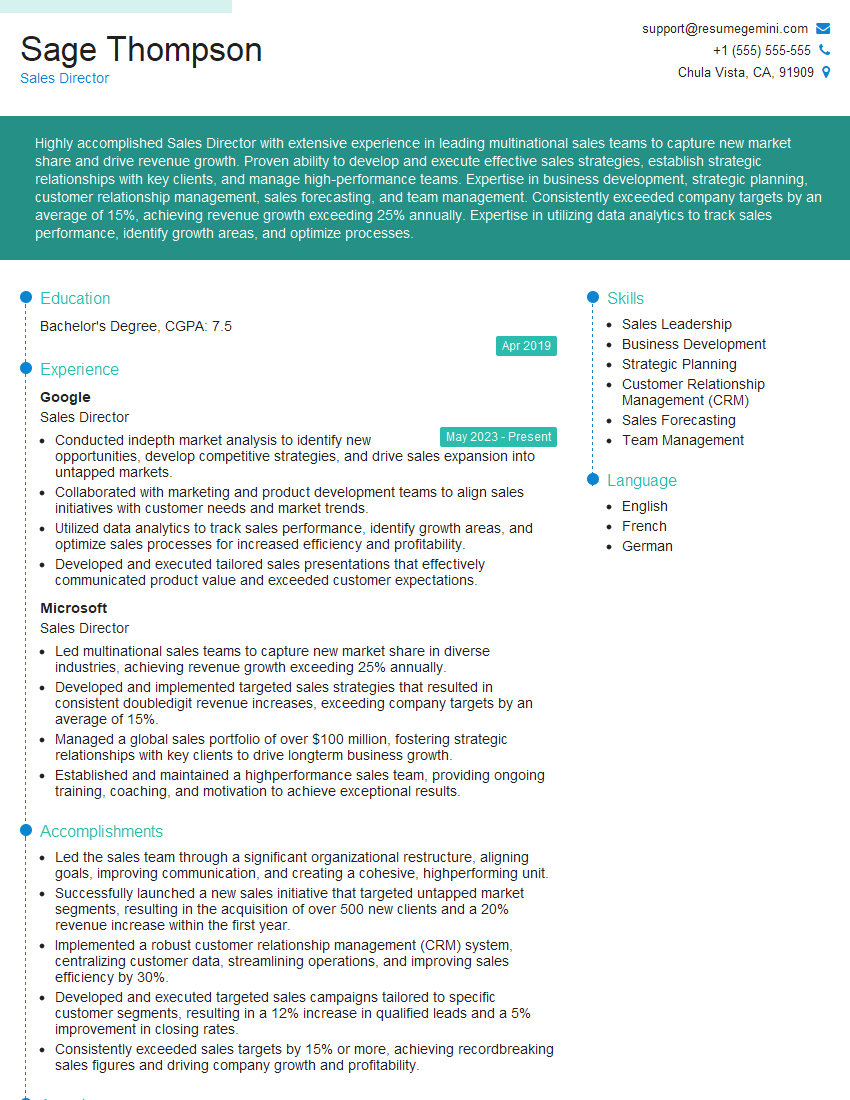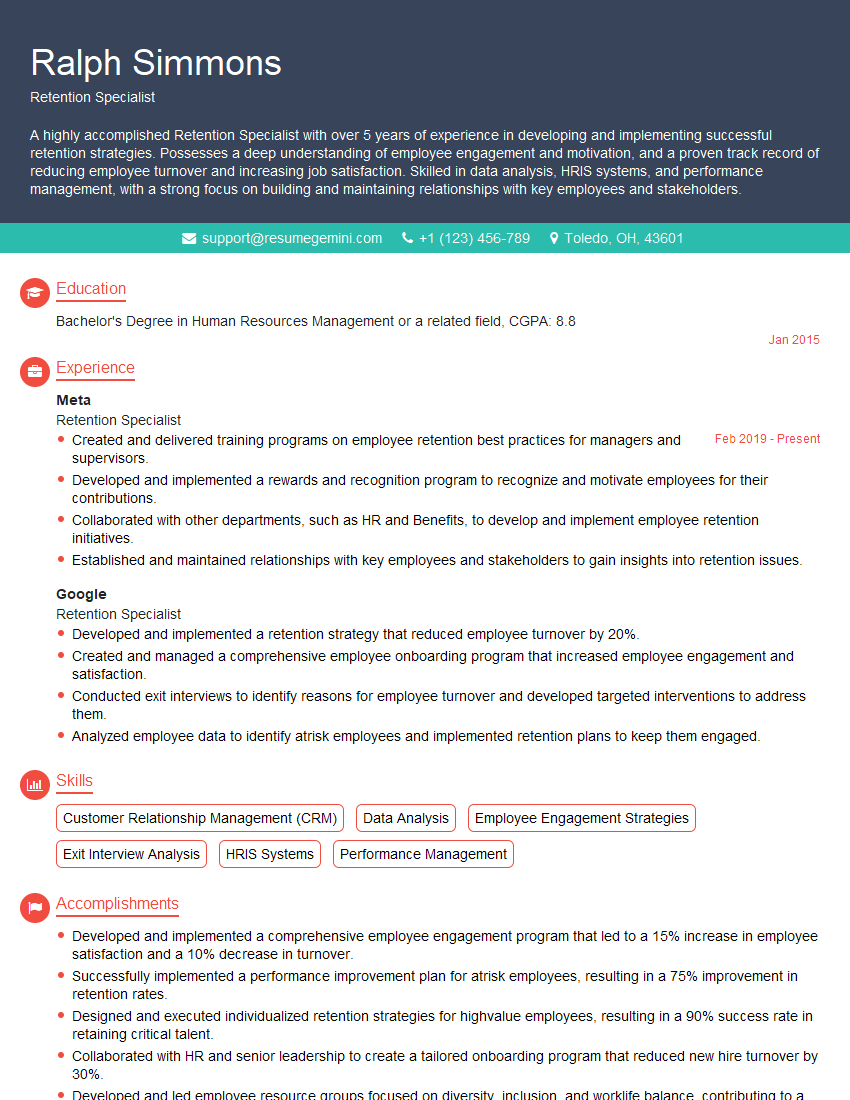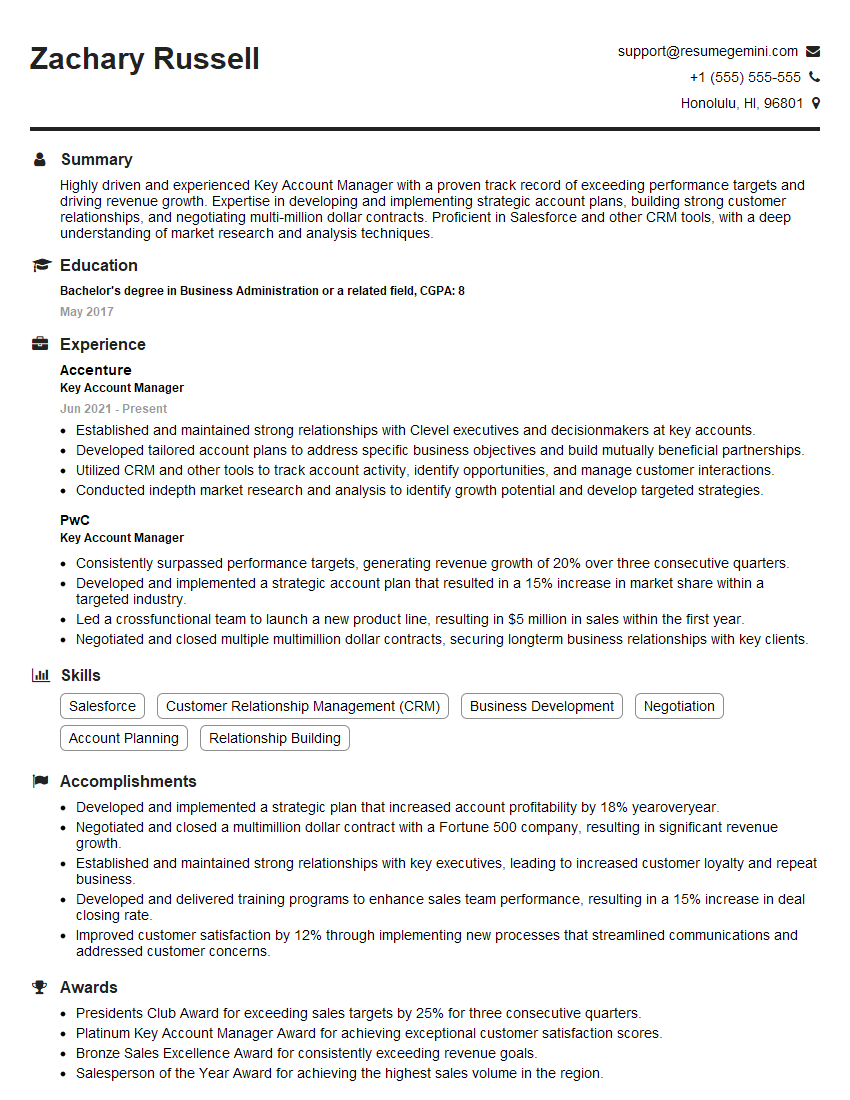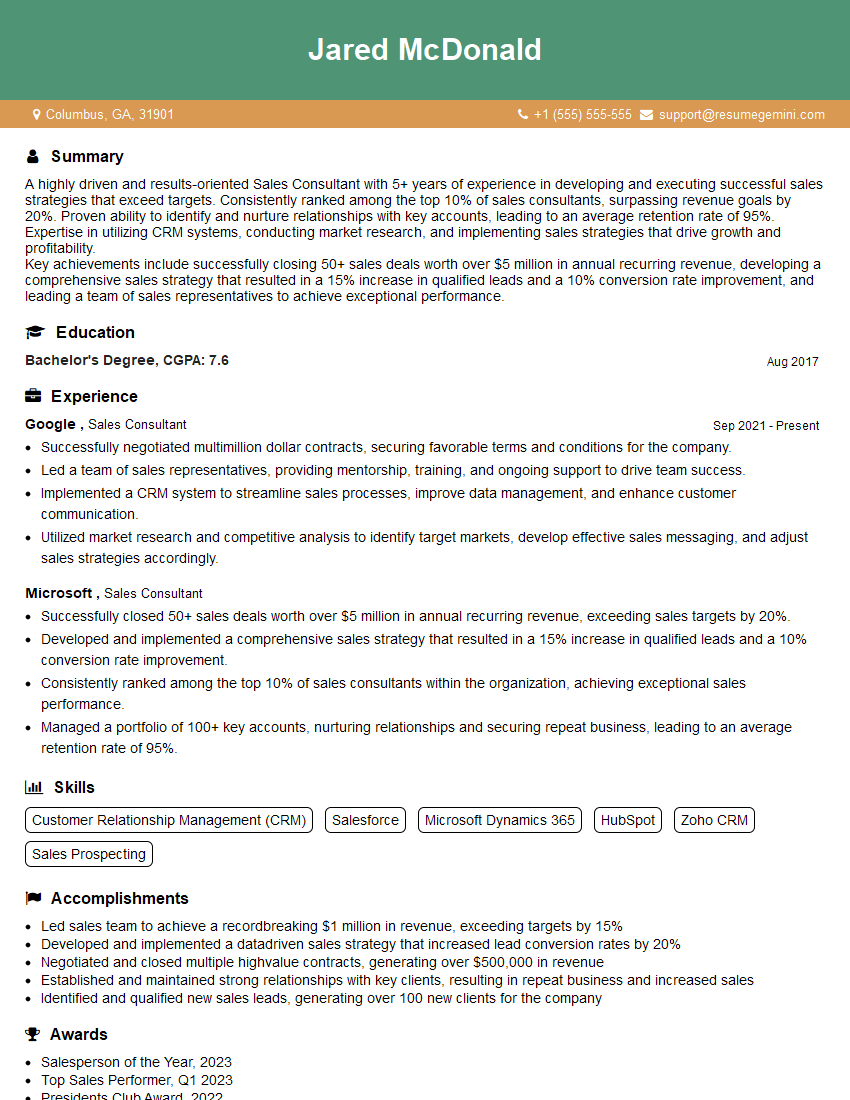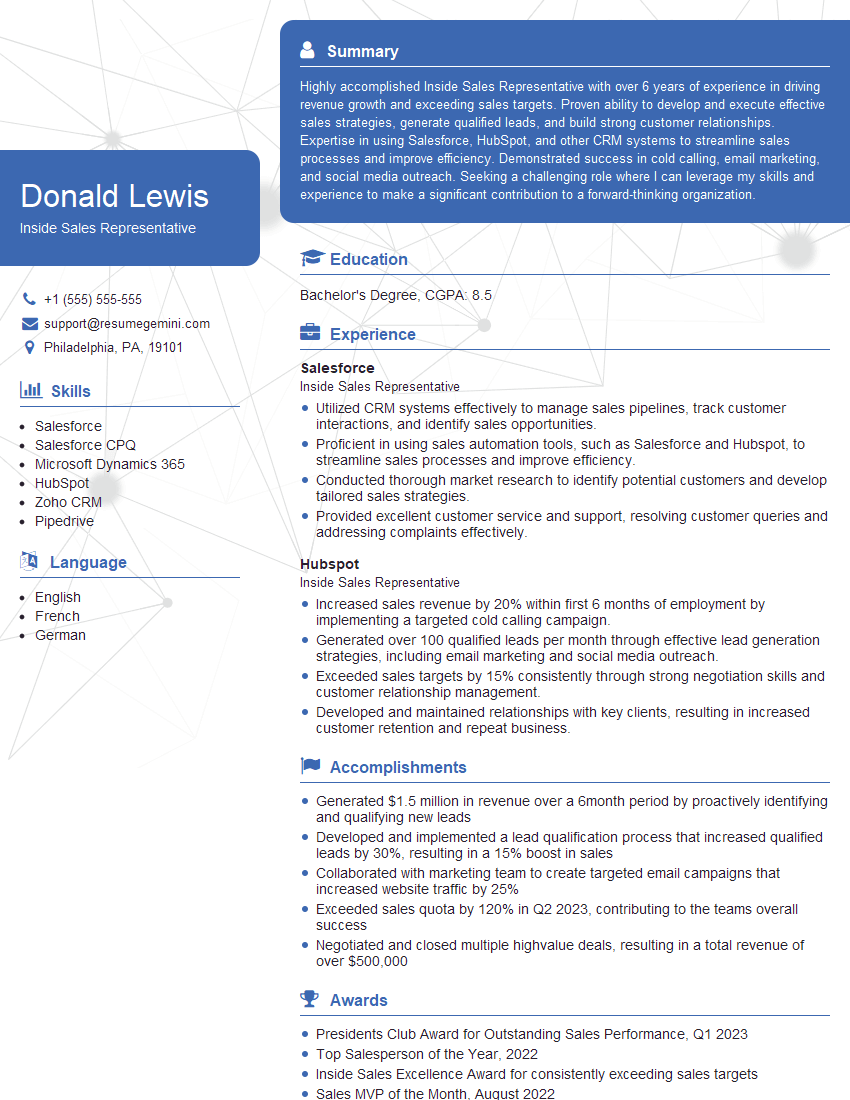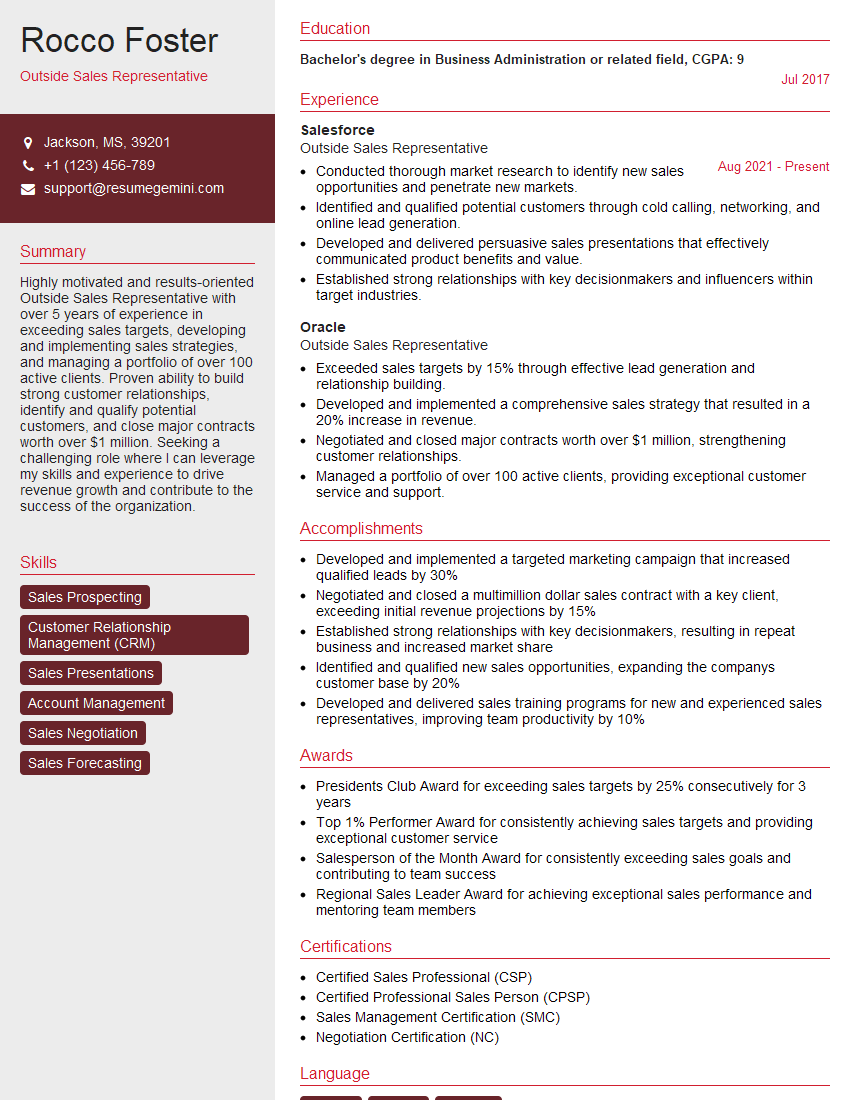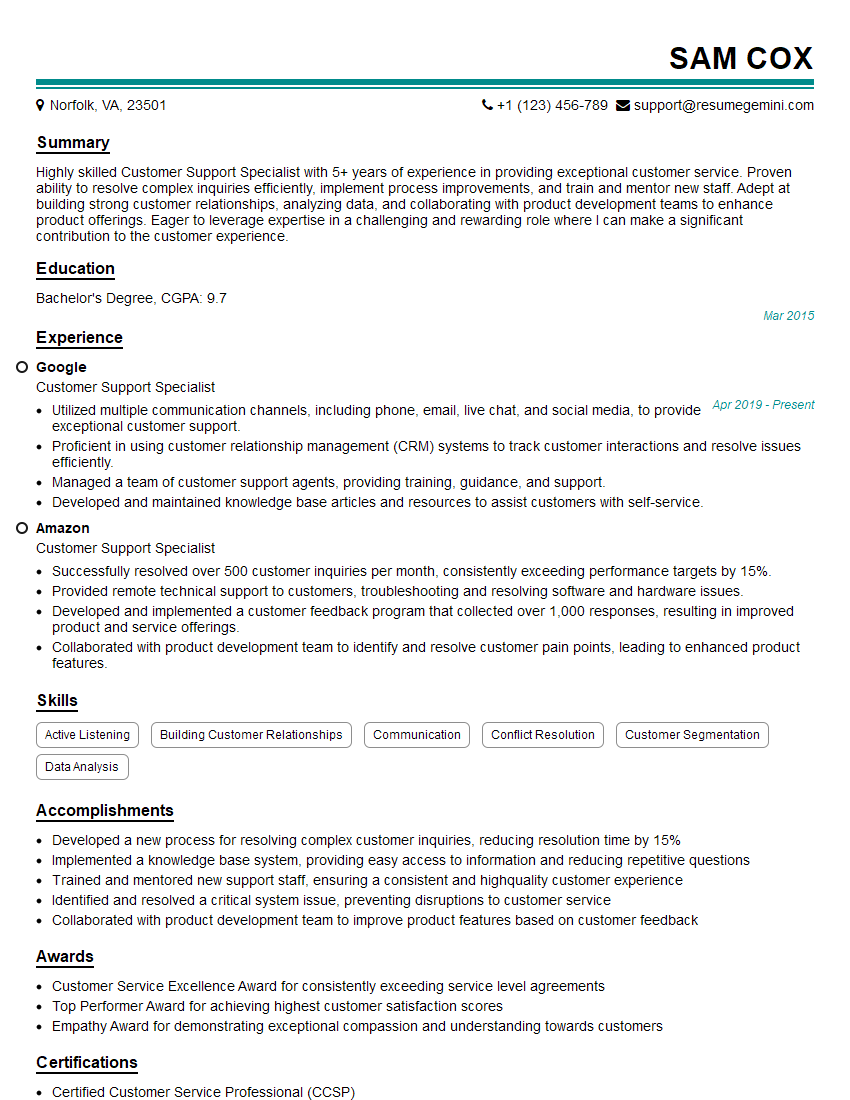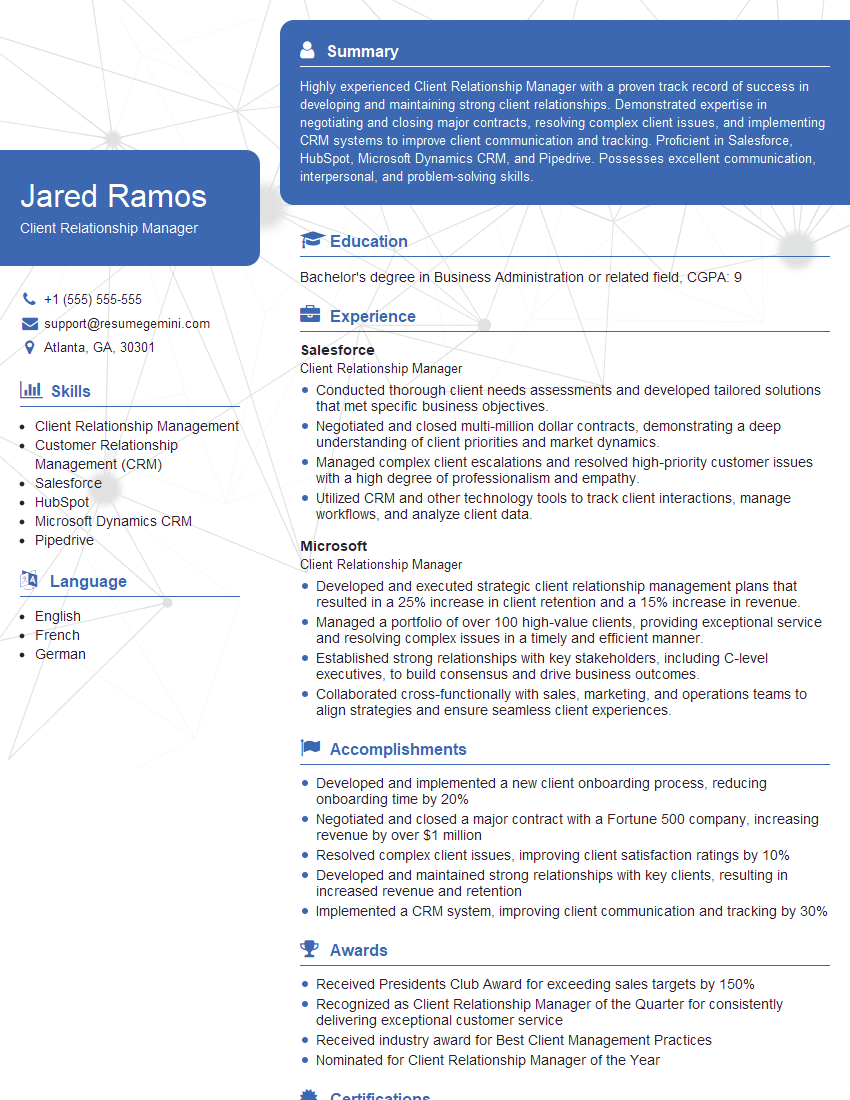Preparation is the key to success in any interview. In this post, we’ll explore crucial Sales and Customer Relations Management interview questions and equip you with strategies to craft impactful answers. Whether you’re a beginner or a pro, these tips will elevate your preparation.
Questions Asked in Sales and Customer Relations Management Interview
Q 1. Describe your sales process.
My sales process is a structured, yet adaptable, approach focused on building relationships and understanding client needs. It’s a blend of strategic planning and responsive execution. I typically follow these key stages:
- Prospecting & Qualification: Identifying potential clients through market research, networking, and lead generation activities. I carefully qualify leads to ensure they align with our ideal customer profile.
- Needs Discovery & Consultation: This involves engaging potential clients through calls, meetings, or demos, actively listening to their challenges, and asking insightful questions to truly understand their requirements. I aim to become a trusted advisor, not just a salesperson.
- Proposal & Presentation: I craft a tailored proposal that directly addresses the client’s specific needs, highlighting the value proposition and demonstrating a clear return on investment (ROI). My presentations are engaging, data-driven, and focused on demonstrating how my solutions solve their problems.
- Negotiation & Closing: This involves addressing client concerns, negotiating terms, and skillfully guiding them toward a mutually beneficial agreement. I focus on building consensus and finding creative solutions to overcome objections.
- Onboarding & Relationship Management: After the sale, I ensure a smooth onboarding process and maintain regular communication to foster a long-term, valuable relationship. This is crucial for repeat business and referrals.
For example, when selling CRM software, I’d begin by understanding the client’s current sales process, identifying pain points (like inefficient lead tracking or poor communication), and then showcasing how our CRM would alleviate those issues and improve their overall efficiency. I would tailor the proposal based on their specific challenges, perhaps focusing on features to improve sales pipeline management or customer communication.
Q 2. How do you handle customer complaints?
Handling customer complaints is crucial for retaining clients and building a positive brand reputation. My approach involves empathy, active listening, and a commitment to finding a fair resolution. I follow these steps:
- Active Listening & Empathy: I let the customer fully explain their issue without interruption. Showing empathy and understanding goes a long way in diffusing frustration. I aim to understand their perspective, not just the facts of the complaint.
- Investigate & Understand: Once I fully understand the issue, I investigate to determine the root cause. This might involve reviewing internal records, consulting with colleagues, or even asking the customer clarifying questions.
- Apologize & Take Ownership (When Appropriate): Even if the complaint isn’t entirely our fault, I’ll apologize for the inconvenience and frustration the customer experienced. Taking ownership fosters trust and goodwill.
- Offer a Solution: I propose a solution that addresses the customer’s concerns fairly and effectively. This might involve a refund, replacement, credit, or some other form of compensation.
- Follow Up: After implementing the solution, I follow up with the customer to ensure they are satisfied and to ascertain if there are any lingering issues.
For instance, if a customer complains about a faulty product, I would first apologize for the inconvenience, then investigate the specific defect, determine if it’s a manufacturing issue or something else, and offer a replacement or refund, depending on the circumstances. I would then follow up to ensure they received the replacement or refund and confirm their satisfaction.
Q 3. What is your experience with CRM software?
I have extensive experience with various CRM software platforms, including Salesforce, HubSpot, and Zoho. My experience encompasses not only using these tools but also customizing and configuring them to meet specific business needs. I’m proficient in data entry, lead management, sales pipeline tracking, reporting and analytics, and integrating the CRM with other business systems.
In my previous role, I played a key role in implementing Salesforce and training the sales team on its effective use. I developed custom reports to track key performance indicators (KPIs), improved lead qualification processes, and ultimately increased sales conversion rates by 15%. My experience extends to utilizing CRM data for forecasting, strategic planning, and identifying areas for improvement in the sales process.
Q 4. How do you prioritize tasks in a high-pressure environment?
Prioritizing tasks in a high-pressure environment requires a strategic approach. I utilize a combination of techniques, including:
- Prioritization Matrix (Eisenhower Matrix): I categorize tasks based on urgency and importance. Urgent and important tasks are addressed immediately, while important but not urgent tasks are scheduled. Urgent but unimportant tasks are delegated or eliminated if possible, and unimportant tasks are discarded.
- Time Blocking: I allocate specific time blocks for tackling high-priority tasks, minimizing distractions, and ensuring focused effort. This technique helps manage time effectively and maintain momentum.
- To-Do Lists & Task Management Software: I use to-do lists and task management tools (like Asana or Trello) to stay organized, track progress, and ensure accountability. Regularly reviewing and updating these lists helps me stay on top of things.
- Delegation: When possible, I delegate tasks to other team members to free up my time for the most critical priorities.
For example, if I’m facing multiple deadlines simultaneously, I would use the Eisenhower Matrix to identify the most critical tasks, allocate specific time blocks for their completion, and delegate less critical tasks to free up my time. Consistent use of task management software helps me track my progress and stay organized amidst the pressure.
Q 5. Explain your approach to closing a deal.
My approach to closing a deal is less about a ‘hard close’ and more about guiding the client toward a decision that’s mutually beneficial. I believe in building a strong relationship throughout the sales process, addressing concerns proactively, and ensuring the client feels confident in their purchase.
I use a consultative approach, focusing on summarizing the value proposition, reiterating how my solution addresses their specific needs, and addressing any remaining objections or uncertainties. I aim to create a sense of urgency without being pushy, highlighting the benefits of acting now, such as special offers or limited-time availability. Finally, I make the closing process clear and straightforward, providing various options and outlining the next steps.
For instance, I might say something like, “Based on our discussions, it’s clear that our solution will significantly improve your efficiency and reduce your operational costs. To move forward, we can begin the implementation process next week with option A or B. Would you prefer to discuss these options in more detail?” The focus is on presenting the next steps clearly and leaving the client feeling empowered to make a decision.
Q 6. How do you build rapport with clients?
Building rapport with clients is essential for successful sales. It’s about establishing trust and a genuine connection. I achieve this by:
- Active Listening: I pay close attention to what clients say, both verbally and nonverbally, demonstrating genuine interest in their needs and perspectives.
- Finding Common Ground: I look for areas of shared interest or experience to build a connection. This can be anything from professional background to hobbies or passions.
- Asking Engaging Questions: I ask open-ended questions that encourage the client to share their thoughts and feelings, allowing me to understand their needs more deeply.
- Personalization: I tailor my communication style to suit each individual client, demonstrating respect and understanding for their unique preferences.
- Professionalism & Integrity: I maintain a professional demeanor while still showing empathy and understanding. Honesty and transparency build trust and credibility.
For example, if I know a client is a keen golfer, I might casually mention a recent golf game I played during a conversation, establishing an informal connection and fostering a more relaxed atmosphere. This casual connection helps me build rapport and create a more comfortable and trusting environment for business discussions.
Q 7. How do you measure success in a sales role?
Measuring success in a sales role involves a multi-faceted approach, going beyond simple revenue figures. Key metrics I track include:
- Revenue & Sales Growth: This is a primary indicator of performance, measuring the overall value of sales generated.
- Conversion Rates: Tracking the percentage of leads that convert into paying customers, highlighting the effectiveness of the sales process.
- Customer Acquisition Cost (CAC): Analyzing the cost of acquiring each new customer, to optimize spending and improve ROI.
- Customer Lifetime Value (CLTV): Assessing the total revenue generated by each customer throughout their relationship with the company, highlighting long-term value.
- Average Deal Size: Tracking the average revenue per deal, which indicates the effectiveness of upselling and cross-selling efforts.
- Customer Satisfaction: Measuring customer satisfaction through surveys, feedback, and reviews to gauge overall client happiness and identify areas for improvement.
By tracking these metrics, I can not only evaluate my individual performance but also identify areas for improvement in the sales process. It also helps to provide data-driven insights for strategic planning and decision-making within the sales team.
Q 8. How do you handle objections from potential clients?
Handling objections is a crucial skill in sales. It’s not about avoiding objections, but about viewing them as opportunities to understand the client’s concerns and address them effectively. My approach is based on active listening, empathy, and providing solutions.
First, I listen carefully to the objection without interrupting. I aim to understand the underlying reason behind the objection, not just the words themselves. This might involve asking clarifying questions like, “Can you tell me more about that?” or “What specifically concerns you about that aspect?”
Once I understand the objection, I address it directly and honestly. If it’s a valid concern, I acknowledge it. For example, if the client is concerned about the price, I might say, “I understand that this is an investment, and it’s important to get value for your money. Let’s explore how this solution can help you achieve [specific benefit] which will significantly outweigh the cost in the long run.” If it’s a misconception, I provide accurate information and clarify any misunderstandings. Sometimes, I might even use a case study or testimonial to reinforce my point.
Finally, I try to reframe the objection as a positive. For example, if a client says they’re unsure about the implementation, I might say, “Your concern about implementation shows you’re thoughtful about this process. Let me show you how our dedicated support team will help you through each step.”
Q 9. Describe a time you exceeded your sales quota.
In my previous role at Acme Corp, I exceeded my sales quota by 25% in Q3 of last year. This wasn’t just due to luck; it was a result of a strategic approach I implemented. I noticed a trend of smaller clients needing a tailored approach to our product suite. I identified this as an untapped market segment.
I developed a new sales pitch specifically targeted at these smaller clients, focusing on the immediate benefits and ROI of our product, rather than the broader, longer-term features. I also created smaller, more affordable packages to cater specifically to their needs and budgets. Finally, I focused on building strong relationships through proactive communication and follow-up.
This strategy involved more direct outreach through targeted LinkedIn campaigns and email marketing. The personalized approach generated more qualified leads, and my tailored packages increased the conversion rate. The result was a significant increase in sales and exceeding my quota substantially. This experience underscored the importance of market segmentation and adapting your sales strategy to suit different customer needs.
Q 10. How do you stay updated on industry trends?
Staying updated on industry trends is vital for success in sales. I utilize a multi-faceted approach. Firstly, I subscribe to relevant industry publications, both print and digital. This includes magazines, newsletters, and online blogs specializing in CRM and sales methodologies. Secondly, I actively participate in online communities and forums, engaging in discussions and learning from others’ experiences.
I regularly attend webinars and industry conferences, both in-person and online. These events provide valuable insights and networking opportunities. I also follow thought leaders and key influencers on platforms like LinkedIn and Twitter, engaging with their content and participating in industry conversations. Finally, I leverage market research reports from reputable firms to gain a deeper understanding of changing customer behavior and market dynamics.
By combining these methods, I maintain a comprehensive understanding of the latest trends, allowing me to adapt my sales strategies and anticipate market shifts proactively.
Q 11. How do you manage your time effectively?
Effective time management is critical in sales. I use a combination of techniques. First, I prioritize tasks based on their urgency and importance using a system like the Eisenhower Matrix (urgent/important). This helps me focus on high-impact activities first. I use a digital calendar to schedule appointments and set reminders, ensuring I allocate sufficient time for each task. I also block out specific times for focused work, minimizing distractions.
To avoid multitasking and maintain focus, I work in time-blocked sessions, dedicating specific time slots to particular tasks. This helps me concentrate better and achieve more in less time. I regularly review my schedule and adjust it as needed to adapt to changing priorities. I also utilize productivity tools such as project management software to keep track of my progress and deadlines. Finally, I delegate tasks whenever possible to free up my time for more strategic activities.
Q 12. What is your experience with lead generation?
My experience with lead generation spans various channels. I’ve successfully utilized inbound marketing strategies such as content marketing (creating blog posts, white papers, and case studies) and search engine optimization (SEO) to attract potential clients organically. I’ve also effectively used outbound tactics, such as cold emailing, targeted LinkedIn outreach, and attending industry events to generate high-quality leads.
In my previous role, I implemented a successful lead nurturing campaign, using email automation to provide valuable content and stay top-of-mind with prospective clients. This increased engagement and conversion rates significantly. I’m proficient in using CRM systems to track leads, manage the sales pipeline, and analyze the effectiveness of different lead generation strategies. I understand the importance of qualifying leads to ensure I focus my efforts on those with the highest potential for conversion. I prefer a multi-channel approach, blending inbound and outbound strategies for optimal results.
Q 13. What sales methodologies are you familiar with (e.g., SPIN selling, Sandler)?
I’m familiar with several sales methodologies, each with its strengths and weaknesses. I adapt my approach depending on the client and the situation. SPIN selling is one I frequently employ. This methodology focuses on asking open-ended questions to uncover the client’s needs, problems, and implications before presenting solutions. It’s a great way to build rapport and demonstrate understanding.
I also have experience with the Sandler sales system, which emphasizes controlling the sales process and identifying a client’s buying process. This involves qualifying the prospect early to avoid wasting time on unqualified leads. I’ve also used aspects of MEDDIC (Metrics, Economic buyer, Decision criteria, Decision process, Paper process, Identifying pain) to qualify large deals. The key is to be adaptable and select the methodology that best suits the specific sales scenario and client interaction.
Q 14. How do you identify and qualify leads?
Identifying and qualifying leads is a crucial process. I use a multi-step approach. First, I define my ideal customer profile (ICP), outlining the characteristics of the clients most likely to benefit from my product or service. This includes factors such as industry, company size, budget, and decision-making process.
Next, I employ various lead generation methods, as described previously, focusing on attracting and capturing leads that match my ICP. Then, I qualify these leads using a set of criteria, often utilizing a scoring system. This might involve evaluating their budget, authority, need, and timeline (BANT). Leads are further qualified based on their engagement with our marketing materials, their responses to outreach efforts, and their expressed interest in our solutions. I use CRM software to automate much of this process and ensure consistent lead qualification across the sales team.
The goal is to prioritize high-quality leads that are more likely to convert into paying customers. This avoids wasting time and resources on unqualified prospects.
Q 15. What is your experience with sales forecasting?
Sales forecasting is the process of estimating future revenue based on historical data, market trends, and sales strategies. It’s crucial for resource allocation, budgeting, and strategic planning. My experience involves utilizing various forecasting methods, including:
- Time series analysis: Examining past sales data to identify patterns and trends (e.g., seasonality, growth rate) to project future sales. For example, I once used moving averages to predict seasonal peaks in e-commerce sales, leading to more efficient inventory management.
- Regression analysis: Identifying correlations between sales and other factors (e.g., marketing spend, economic indicators) to build predictive models. I used this approach to model the impact of digital marketing campaigns on lead generation and ultimately, sales.
- Qualitative forecasting: Incorporating expert opinions and market research to refine quantitative forecasts. This is particularly valuable when dealing with new products or entering new markets. I’ve used this method in situations with limited historical data, supplementing with market research insights from industry experts.
I’m proficient in using software tools like Salesforce and Excel to build and visualize these forecasts, ensuring accuracy and timely delivery of information to stakeholders.
Career Expert Tips:
- Ace those interviews! Prepare effectively by reviewing the Top 50 Most Common Interview Questions on ResumeGemini.
- Navigate your job search with confidence! Explore a wide range of Career Tips on ResumeGemini. Learn about common challenges and recommendations to overcome them.
- Craft the perfect resume! Master the Art of Resume Writing with ResumeGemini’s guide. Showcase your unique qualifications and achievements effectively.
- Don’t miss out on holiday savings! Build your dream resume with ResumeGemini’s ATS optimized templates.
Q 16. Describe your experience with account planning.
Account planning is the systematic process of developing a tailored strategy for managing and growing relationships with key clients. It involves a deep understanding of the client’s business, needs, and objectives. My experience encompasses:
- Client profiling: Thorough research into client’s industry, competitive landscape, organizational structure, and key decision-makers. This informs our approach and ensures we’re addressing their specific challenges.
- Value proposition development: Defining how our products/services address client needs and generate value, often surpassing competitor offerings. I’ve developed compelling value propositions focusing on ROI and cost savings, leading to successful contract renewals.
- Relationship mapping: Identifying key stakeholders within the client’s organization and building relationships with them. This helps ensure buy-in from all relevant parties and facilitates efficient communication.
- Strategic plan creation: Developing a detailed plan outlining short-term and long-term goals, tactics, and performance metrics for each key account. This plan serves as a roadmap for consistent engagement and growth.
For example, I developed a comprehensive account plan for a major technology client, focusing on cross-selling opportunities and strategic partnerships. This resulted in a significant increase in their spend and strengthened our long-term relationship.
Q 17. How do you handle difficult clients?
Handling difficult clients requires patience, empathy, and a structured approach. I focus on:
- Active listening: Understanding the client’s concerns and perspective, even if they’re expressed negatively. This shows respect and facilitates open communication.
- Empathy and validation: Acknowledging the client’s feelings and validating their concerns, even if I don’t necessarily agree. I might say something like, “I understand your frustration with the delay.” This diffuses tension.
- Problem-solving: Collaboratively working with the client to identify solutions, focusing on what’s possible rather than dwelling on the problem. I might suggest alternative solutions or propose a revised timeline.
- Professional boundaries: Maintaining professionalism even when faced with aggressive or unreasonable behavior. I firmly but calmly address inappropriate conduct while still attempting resolution.
In one instance, a client was extremely upset about a delivery delay. By actively listening, acknowledging their frustration, and offering a proactive solution (expedited shipping and a discount), I turned a potentially disastrous situation into a strengthened relationship.
Q 18. What is your approach to customer retention?
Customer retention focuses on building long-term relationships and ensuring clients continue doing business with us. My approach involves:
- Proactive communication: Regularly checking in with clients to understand their needs and address any potential issues before they escalate. This could be through regular emails, phone calls, or surveys.
- Personalized service: Providing tailored solutions and experiences that reflect an understanding of each client’s individual requirements. This includes remembering client preferences and adapting my approach accordingly.
- Loyalty programs: Implementing rewards or incentives for repeat business. This could be discounts, exclusive offers, or early access to new products/services.
- Feedback collection and improvement: Regularly soliciting feedback from clients and using it to improve our products, services, and processes. This shows clients we value their input and are committed to improvement.
For example, I implemented a client feedback program that significantly improved our customer satisfaction scores and reduced churn rate.
Q 19. Describe a time you had to adapt your sales strategy.
I adapted my sales strategy when our company launched a new product with a significantly higher price point than our existing offerings. Our initial strategy, focusing on volume sales, wasn’t effective. I adapted by:
- Refocusing on value: Instead of emphasizing price, I highlighted the increased value and ROI the new product offered, emphasizing its long-term benefits and cost savings.
- Targeting a different audience segment: We initially targeted our existing customer base. I shifted focus to larger enterprises with a higher budget and a greater need for the premium features of the new product.
- Adjusting sales messaging: Our initial messaging was too focused on features. I adjusted it to emphasize the unique value propositions and benefits for the target audience.
This adaptation resulted in increased sales of the new product, exceeding initial projections.
Q 20. How do you handle conflict resolution with clients?
Conflict resolution with clients requires a calm, professional approach focusing on mutual understanding and finding a mutually agreeable solution. My process is:
- Active listening and understanding: Carefully listen to the client’s perspective, seeking to understand their concerns and the root cause of the conflict.
- Empathy and validation: Acknowledging the client’s feelings and validating their concerns, even if I don’t necessarily agree.
- Collaboration and compromise: Working collaboratively with the client to find a mutually acceptable solution. This might involve negotiation and compromise from both sides.
- Documentation: Documenting the conflict, the steps taken to resolve it, and the final agreement reached.
For instance, I once resolved a pricing dispute with a client by carefully reviewing the contract, acknowledging a potential oversight, and offering a partial refund. This demonstrated fairness and strengthened our relationship.
Q 21. What are your salary expectations?
My salary expectations are in the range of $ [Insert Salary Range] annually, commensurate with my experience and skills in sales and customer relationship management. This range reflects my proven ability to consistently exceed sales targets, build strong client relationships, and contribute significantly to business growth. I am open to discussing this further based on the specifics of the role and the overall compensation package.
Q 22. Why are you interested in this role?
I’m deeply interested in this role because it perfectly aligns with my passion for driving sales growth and fostering strong customer relationships. My experience in developing and implementing successful sales strategies, coupled with my expertise in CRM systems, makes me confident in my ability to significantly contribute to your team. The opportunity to work with a [mention company name or industry if known] in a role that leverages both my analytical skills and my interpersonal strengths is particularly exciting. I’m eager to learn from experienced professionals and contribute my knowledge to achieve shared success.
Q 23. What are your strengths and weaknesses?
One of my greatest strengths is my ability to build rapport with clients and understand their needs. I’ve consistently exceeded sales targets by proactively identifying and addressing customer pain points. For instance, in my previous role at [Previous Company Name], I identified a key unmet need in our customer base through careful analysis of CRM data and feedback. This led to the development of a new product feature that resulted in a 20% increase in sales within the first quarter. A weakness I’m actively working on is delegating tasks efficiently. While I’m highly detail-oriented, I sometimes struggle to let go of certain responsibilities. I’m addressing this by implementing time management techniques and prioritizing tasks more effectively, utilizing project management tools like Asana to improve workflow and collaboration.
Q 24. What are your long-term career goals?
My long-term career goals involve becoming a leader in the field of Sales and Customer Relationship Management. I aspire to hold a senior management position where I can mentor and develop teams, implement innovative sales strategies, and drive significant business growth. I’m particularly interested in leveraging data-driven insights to optimize sales processes and enhance customer experience. Ultimately, I aim to contribute to building high-performing, customer-centric organizations.
Q 25. Where do you see yourself in 5 years?
In five years, I see myself as a highly effective sales manager or a senior sales representative within a leading organization. I envision myself having successfully managed and mentored a team, consistently exceeding sales targets, and playing a key role in developing and implementing company-wide sales strategies. I’d also like to have significantly expanded my expertise in areas such as sales forecasting, advanced CRM analytics, and strategic account management.
Q 26. How do you handle rejection?
Rejection is an inevitable part of sales. I view it not as a personal failure, but as an opportunity for learning and growth. When faced with rejection, I analyze the situation to understand what factors may have contributed to the negative outcome. This might involve reviewing my sales pitch, understanding the customer’s objections, or refining my approach. I then use this feedback to improve my strategy and increase my chances of success in future interactions. Maintaining a positive attitude and perseverance are crucial in overcoming setbacks and achieving long-term success in sales.
Q 27. Describe your experience with cross-functional collaboration.
I have extensive experience in cross-functional collaboration. In my previous role, I regularly collaborated with marketing, product development, and customer service teams. For example, I worked closely with the marketing team to align sales campaigns with product launches. This involved providing feedback on marketing materials, sharing insights from customer interactions, and contributing to the development of targeted marketing strategies. With the product development team, I provided feedback on product features based on customer needs, which directly improved product-market fit. Effective communication, active listening, and a willingness to compromise are key to successful cross-functional collaboration. I believe in building strong working relationships with colleagues across departments to achieve common goals.
Key Topics to Learn for Sales and Customer Relations Management Interview
- Understanding Customer Needs: Learn to actively listen and identify underlying customer needs beyond explicitly stated requests. This includes recognizing unspoken needs and potential objections.
- Building Rapport and Trust: Practice techniques for establishing rapport quickly and building trust with potential and existing clients. Consider how to adapt your communication style to different personalities and situations.
- Effective Communication Strategies: Master clear, concise, and persuasive communication, both written and verbal. Practice presenting complex information in a simple and understandable way.
- Sales Process and Methodologies: Familiarize yourself with various sales methodologies (e.g., SPIN selling, solution selling) and understand their practical application in different sales scenarios.
- Negotiation and Conflict Resolution: Develop strategies for effectively negotiating deals and resolving customer conflicts professionally and amicably. Practice finding win-win solutions.
- CRM Software and Tools: Understand the importance of CRM systems in managing customer relationships and sales pipelines. Be prepared to discuss your experience with popular CRM platforms (if any).
- Sales Metrics and KPIs: Know how to track and analyze key performance indicators (KPIs) related to sales and customer satisfaction. Understand how these metrics inform strategic decision-making.
- Customer Retention Strategies: Explore techniques for retaining existing customers, building loyalty, and fostering long-term relationships. This includes understanding customer lifetime value.
- Problem-Solving and Decision-Making: Be ready to discuss how you approach challenges in sales and customer service situations, showcasing your problem-solving skills and ability to make informed decisions under pressure.
- Ethical Sales Practices: Understand and uphold ethical standards in all sales and customer interactions. Be prepared to discuss situations requiring ethical decision-making.
Next Steps
Mastering Sales and Customer Relations Management is crucial for career advancement, opening doors to leadership roles and higher earning potential. An ATS-friendly resume is your key to unlocking these opportunities. Make sure yours showcases your skills and experience effectively. ResumeGemini is a trusted resource to help you craft a compelling and ATS-optimized resume that truly highlights your qualifications. We provide examples of resumes tailored to Sales and Customer Relations Management to help you get started.
Explore more articles
Users Rating of Our Blogs
Share Your Experience
We value your feedback! Please rate our content and share your thoughts (optional).
What Readers Say About Our Blog
Hello,
We found issues with your domain’s email setup that may be sending your messages to spam or blocking them completely. InboxShield Mini shows you how to fix it in minutes — no tech skills required.
Scan your domain now for details: https://inboxshield-mini.com/
— Adam @ InboxShield Mini
Reply STOP to unsubscribe
Hi, are you owner of interviewgemini.com? What if I told you I could help you find extra time in your schedule, reconnect with leads you didn’t even realize you missed, and bring in more “I want to work with you” conversations, without increasing your ad spend or hiring a full-time employee?
All with a flexible, budget-friendly service that could easily pay for itself. Sounds good?
Would it be nice to jump on a quick 10-minute call so I can show you exactly how we make this work?
Best,
Hapei
Marketing Director
Hey, I know you’re the owner of interviewgemini.com. I’ll be quick.
Fundraising for your business is tough and time-consuming. We make it easier by guaranteeing two private investor meetings each month, for six months. No demos, no pitch events – just direct introductions to active investors matched to your startup.
If youR17;re raising, this could help you build real momentum. Want me to send more info?
Hi, I represent an SEO company that specialises in getting you AI citations and higher rankings on Google. I’d like to offer you a 100% free SEO audit for your website. Would you be interested?
Hi, I represent an SEO company that specialises in getting you AI citations and higher rankings on Google. I’d like to offer you a 100% free SEO audit for your website. Would you be interested?
good



